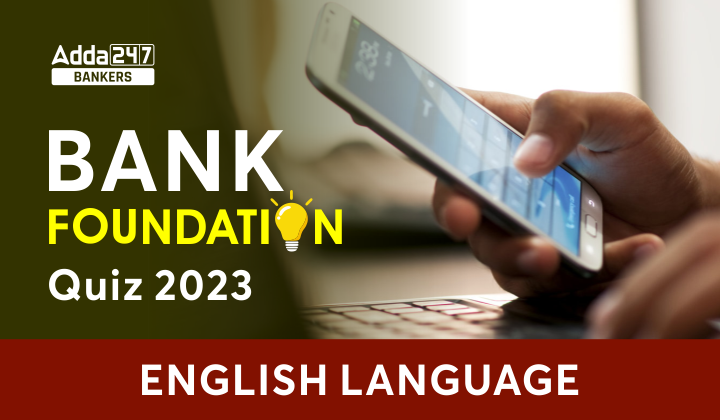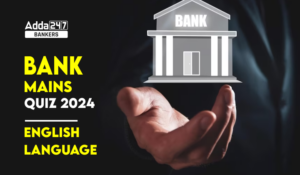Directions (1-8): In the following given passage, certain words are highlighted which may or may not be fit in the sentence either grammatically or contextually. Each word is numbered followed by four possible replacements. If none of the given option could replace the highlighted word, mark your answer, (e); “None of the above”.
Q1. The Indian economy is going through a extend (1) crisis: a slowdown as well as a structural crisis. In the words of the former Chief Economic Adviser, Arvind Subramanian, it is headed towards the ICU. Almost all sectors of the economy are in decline: the rate of growth of the national GDP has obtain (2) to 5.0%, and may go down further; the construction sector, one of the fastest growing sectors so far, is growing at 3.3% this year; agriculture is growing at 2.1% while the auto sector is declining continuously in property (3) terms.
The Micro, Small and Medium Enterprises (MSME) sector too has declined, in turn raising the commission (4) of non-performing assets of the banking sector as well as non-banking financial institutions. Also, exports have been declining in recent years, raising the crisis of current account justify (5). Credit from banking and non-banking sectors has been declining in the last few years; the Financial Stability Report of the Reserve Bank of India (2019) says that it is unlikely to increase in the next nine months.
These developments have had an attribute (6) impact on the bottom 30%-40% of the population. The incidence of absolute poverty, which has been disposition (7) since 1972-73, has increased to 30% (4% jump). As the Human Development Report (2019) has shown, more than 44% of the Indian population is under the multi-dimensional poverty line. The poorest 50% population at present owns only 4.1% of the national bestow (8), while the richest 10% people own 73% of the total wealth in India (Suisse Credit 2019).
(a) Allege
(b) Lofty
(c) Severe
(d) Multitude
(e) None of these
Q2. The Indian economy is going through a extend (1) crisis: a slowdown as well as a structural crisis. In the words of the former Chief Economic Adviser, Arvind Subramanian, it is headed towards the ICU. Almost all sectors of the economy are in decline: the rate of growth of the national GDP has obtain (2) to 5.0%, and may go down further; the construction sector, one of the fastest growing sectors so far, is growing at 3.3% this year; agriculture is growing at 2.1% while the auto sector is declining continuously in property (3) terms.
The Micro, Small and Medium Enterprises (MSME) sector too has declined, in turn raising the commission (4) of non-performing assets of the banking sector as well as non-banking financial institutions. Also, exports have been declining in recent years, raising the crisis of current account justify (5). Credit from banking and non-banking sectors has been declining in the last few years; the Financial Stability Report of the Reserve Bank of India (2019) says that it is unlikely to increase in the next nine months.
These developments have had an attribute (6) impact on the bottom 30%-40% of the population. The incidence of absolute poverty, which has been disposition (7) since 1972-73, has increased to 30% (4% jump). As the Human Development Report (2019) has shown, more than 44% of the Indian population is under the multi-dimensional poverty line. The poorest 50% population at present owns only 4.1% of the national bestow (8), while the richest 10% people own 73% of the total wealth in India (Suisse Credit 2019).
(a) Declined
(b) Modest
(c) Partial
(d) Esteem
(e) None of these
Q3. The Indian economy is going through a extend (1) crisis: a slowdown as well as a structural crisis. In the words of the former Chief Economic Adviser, Arvind Subramanian, it is headed towards the ICU. Almost all sectors of the economy are in decline: the rate of growth of the national GDP has obtain (2) to 5.0%, and may go down further; the construction sector, one of the fastest growing sectors so far, is growing at 3.3% this year; agriculture is growing at 2.1% while the auto sector is declining continuously in property (3) terms.
The Micro, Small and Medium Enterprises (MSME) sector too has declined, in turn raising the commission (4) of non-performing assets of the banking sector as well as non-banking financial institutions. Also, exports have been declining in recent years, raising the crisis of current account justify (5). Credit from banking and non-banking sectors has been declining in the last few years; the Financial Stability Report of the Reserve Bank of India (2019) says that it is unlikely to increase in the next nine months.
These developments have had an attribute (6) impact on the bottom 30%-40% of the population. The incidence of absolute poverty, which has been disposition (7) since 1972-73, has increased to 30% (4% jump). As the Human Development Report (2019) has shown, more than 44% of the Indian population is under the multi-dimensional poverty line. The poorest 50% population at present owns only 4.1% of the national bestow (8), while the richest 10% people own 73% of the total wealth in India (Suisse Credit 2019).
(a) Creditable
(b) Tread
(c) Provoke
(d) Absolute
(e) None of these
Q4. The Indian economy is going through a extend (1) crisis: a slowdown as well as a structural crisis. In the words of the former Chief Economic Adviser, Arvind Subramanian, it is headed towards the ICU. Almost all sectors of the economy are in decline: the rate of growth of the national GDP has obtain (2) to 5.0%, and may go down further; the construction sector, one of the fastest growing sectors so far, is growing at 3.3% this year; agriculture is growing at 2.1% while the auto sector is declining continuously in property (3) terms.
The Micro, Small and Medium Enterprises (MSME) sector too has declined, in turn raising the commission (4) of non-performing assets of the banking sector as well as non-banking financial institutions. Also, exports have been declining in recent years, raising the crisis of current account justify (5). Credit from banking and non-banking sectors has been declining in the last few years; the Financial Stability Report of the Reserve Bank of India (2019) says that it is unlikely to increase in the next nine months.
These developments have had an attribute (6) impact on the bottom 30%-40% of the population. The incidence of absolute poverty, which has been disposition (7) since 1972-73, has increased to 30% (4% jump). As the Human Development Report (2019) has shown, more than 44% of the Indian population is under the multi-dimensional poverty line. The poorest 50% population at present owns only 4.1% of the national bestow (8), while the richest 10% people own 73% of the total wealth in India (Suisse Credit 2019).
(a) Ascertain
(b) Burden
(c) Cede
(d) Decree
(e) None of these
Q5. The Indian economy is going through a extend (1) crisis: a slowdown as well as a structural crisis. In the words of the former Chief Economic Adviser, Arvind Subramanian, it is headed towards the ICU. Almost all sectors of the economy are in decline: the rate of growth of the national GDP has obtain (2) to 5.0%, and may go down further; the construction sector, one of the fastest growing sectors so far, is growing at 3.3% this year; agriculture is growing at 2.1% while the auto sector is declining continuously in property (3) terms.
The Micro, Small and Medium Enterprises (MSME) sector too has declined, in turn raising the commission (4) of non-performing assets of the banking sector as well as non-banking financial institutions. Also, exports have been declining in recent years, raising the crisis of current account justify (5). Credit from banking and non-banking sectors has been declining in the last few years; the Financial Stability Report of the Reserve Bank of India (2019) says that it is unlikely to increase in the next nine months.
These developments have had an attribute (6) impact on the bottom 30%-40% of the population. The incidence of absolute poverty, which has been disposition (7) since 1972-73, has increased to 30% (4% jump). As the Human Development Report (2019) has shown, more than 44% of the Indian population is under the multi-dimensional poverty line. The poorest 50% population at present owns only 4.1% of the national bestow (8), while the richest 10% people own 73% of the total wealth in India (Suisse Credit 2019).
(a) Derived
(b) Contrive
(c) Deficit
(d) Elaborate
(e) None of these
Q6. The Indian economy is going through a extend (1) crisis: a slowdown as well as a structural crisis. In the words of the former Chief Economic Adviser, Arvind Subramanian, it is headed towards the ICU. Almost all sectors of the economy are in decline: the rate of growth of the national GDP has obtain (2) to 5.0%, and may go down further; the construction sector, one of the fastest growing sectors so far, is growing at 3.3% this year; agriculture is growing at 2.1% while the auto sector is declining continuously in property (3) terms.
The Micro, Small and Medium Enterprises (MSME) sector too has declined, in turn raising the commission (4) of non-performing assets of the banking sector as well as non-banking financial institutions. Also, exports have been declining in recent years, raising the crisis of current account justify (5). Credit from banking and non-banking sectors has been declining in the last few years; the Financial Stability Report of the Reserve Bank of India (2019) says that it is unlikely to increase in the next nine months.
These developments have had an attribute (6) impact on the bottom 30%-40% of the population. The incidence of absolute poverty, which has been disposition (7) since 1972-73, has increased to 30% (4% jump). As the Human Development Report (2019) has shown, more than 44% of the Indian population is under the multi-dimensional poverty line. The poorest 50% population at present owns only 4.1% of the national bestow (8), while the richest 10% people own 73% of the total wealth in India (Suisse Credit 2019).
(a) Adverse
(b) Substantially
(c) Frontier
(d) Citation
(e) None of these
Q7. The Indian economy is going through a extend (1) crisis: a slowdown as well as a structural crisis. In the words of the former Chief Economic Adviser, Arvind Subramanian, it is headed towards the ICU. Almost all sectors of the economy are in decline: the rate of growth of the national GDP has obtain (2) to 5.0%, and may go down further; the construction sector, one of the fastest growing sectors so far, is growing at 3.3% this year; agriculture is growing at 2.1% while the auto sector is declining continuously in property (3) terms.
The Micro, Small and Medium Enterprises (MSME) sector too has declined, in turn raising the commission (4) of non-performing assets of the banking sector as well as non-banking financial institutions. Also, exports have been declining in recent years, raising the crisis of current account justify (5). Credit from banking and non-banking sectors has been declining in the last few years; the Financial Stability Report of the Reserve Bank of India (2019) says that it is unlikely to increase in the next nine months.
These developments have had an attribute (6) impact on the bottom 30%-40% of the population. The incidence of absolute poverty, which has been disposition (7) since 1972-73, has increased to 30% (4% jump). As the Human Development Report (2019) has shown, more than 44% of the Indian population is under the multi-dimensional poverty line. The poorest 50% population at present owns only 4.1% of the national bestow (8), while the richest 10% people own 73% of the total wealth in India (Suisse Credit 2019).
(a) Warrant
(b) Sob
(c) Falling
(d) Dense
(e) None of these
Q8. The Indian economy is going through a extend (1) crisis: a slowdown as well as a structural crisis. In the words of the former Chief Economic Adviser, Arvind Subramanian, it is headed towards the ICU. Almost all sectors of the economy are in decline: the rate of growth of the national GDP has obtain (2) to 5.0%, and may go down further; the construction sector, one of the fastest growing sectors so far, is growing at 3.3% this year; agriculture is growing at 2.1% while the auto sector is declining continuously in property (3) terms.
The Micro, Small and Medium Enterprises (MSME) sector too has declined, in turn raising the commission (4) of non-performing assets of the banking sector as well as non-banking financial institutions. Also, exports have been declining in recent years, raising the crisis of current account justify (5). Credit from banking and non-banking sectors has been declining in the last few years; the Financial Stability Report of the Reserve Bank of India (2019) says that it is unlikely to increase in the next nine months.
These developments have had an attribute (6) impact on the bottom 30%-40% of the population. The incidence of absolute poverty, which has been disposition (7) since 1972-73, has increased to 30% (4% jump). As the Human Development Report (2019) has shown, more than 44% of the Indian population is under the multi-dimensional poverty line. The poorest 50% population at present owns only 4.1% of the national bestow (8), while the richest 10% people own 73% of the total wealth in India (Suisse Credit 2019).
(a) Afflict
(b) Wealth
(c) Flourish
(d) Ordain
(e) None of these
Directions (9-10): Given below the sentences each of which has been divided into four parts. Each of the questions is then followed by the five options which give the sequence of the rearranged parts. You must choose the option which gives the correct sequence of the parts. If the sentence is already arranged in the correct sequence or the correct sequence doesn’t match with any of the given sequence, mark option (e) .i.e. ‘None of the above’ as your answer.
Q9. if the public expenditure on raising (A)/capabilities is treated as social investment (B)/ be willing to spend on the capital formation (C)/ rather than social welfare, policymakers will (D)
(a) BADC
(b) ADBC
(c) ABDC
(d) ACBD
(e) None of the above
Q10. in India have not developed to ensure (A)/ since the electoral system and conventions (B) /reasons for Speakers to retain party membership (C)/ protection to the office, there are cogent (D)
(a) BADC
(b) ADBC
(c) ABDC
(d) ACBD
(e) None of the above
Solutions:
S1. Ans. (c)
Sol. ‘Severe’ can replace the highlighted word. Hence, option (c) is the right answer choice.
S2. Ans. (a)
Sol. ‘Declined’ can replace the highlighted word. Hence, option (a) is the right answer choice.
S3. Ans. (d)
Sol. ‘Absolute’ can replace the highlighted word. Hence, option (d) is the right answer choice.
S4. Ans. (b)
Sol. ‘Burden’ can replace the highlighted word. Hence, option (b) is the right answer choice.
S5. Ans. (c)
Sol. ‘Deficit’ can replace the highlighted word. Hence, option (c) is the right answer choice.
S6. Ans. (a)
Sol. ‘Adverse’ can replace the highlighted word. Hence, option (a) is the right answer choice.
S7. Ans. (c)
Sol. ‘Falling’ can replace the highlighted word. Hence, option (c) is the right answer choice.
S8. Ans. (b)
Sol. ‘Wealth’ can replace the highlighted word. Hence, option (b) is the right answer choice.
S9. Ans. (c)
Sol. The correct sequence is ABDC. The sentence after rearrangement is, ‘If the public expenditure on raising capabilities is treated as social investment rather than social welfare, policymakers will be willing to spend on this capital formation.’
Hence, option (c) is the right answer choice.
S10. Ans. (a)
Sol. The correct sequence is BADC. The sentence after rearrangement is, ‘Since the electoral system and conventions in India have ‘not developed to ensure protection to the office, there are cogent reasons for Speakers to retain party membership’
Hence, option (a) is the right answer choice.





 English Language Quiz For Bank Foundatio...
English Language Quiz For Bank Foundatio...
 English Language Quiz For Bank Mains Exa...
English Language Quiz For Bank Mains Exa...


